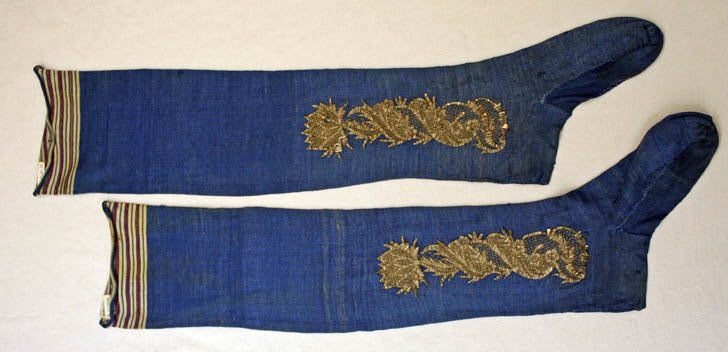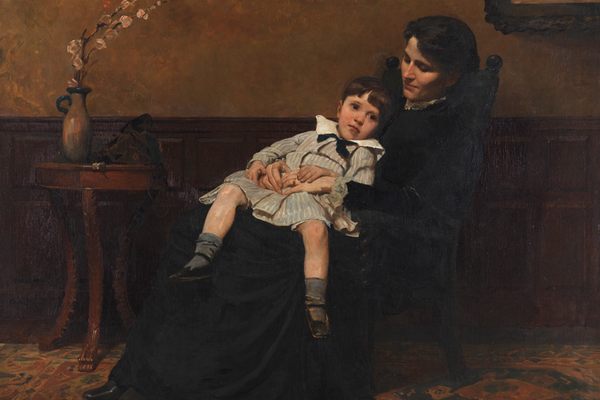A Machine That Made Stockings Helped Kick Off the Industrial Revolution
Queen Elizabeth I wanted none of it.

In early 1590s, Lord Hunsdon, a chamberlain of Queen Elizabeth I, brought her an object to consider, one that he considered a marvelous invention. It was a stocking, somewhat coarsely made. The queen was known for her fondness for these undergarments; she had first received a pair at Christmas in 1561, from her silk woman, one Mrs. Montague. In the 16th century, both women and men covered their legs with hosiery, knit by hand and stitched together in the form of a person’s leg. But these stockings were different. They were not hand-knit. They had been made by machine.
Queen Elizabeth had some sense of what mechanically produced stockings might mean, and she wanted none of it. “I have too much love for my poor people who obtain their bread by the employment of knitting to give my money to forward an invention that will tend to their ruin by depriving them of employment and thus making them beggars,” she pronounced.
Today, stockings are hardly the object of controversy. But from then to the early 19th century, machine-made stockings were at the forefront of the Industrial Revolution. European royals subsidized their manufacture, industrial spies went after the technology to make them, and political dissidents smashed the frames on which they were made. These delicate undergarments heralded the economic transformation that would change the world.

Most men in the late 1500s would not have bothered themselves with the making of hosiery, and William Lee’s inspiration for creating a stocking-knitting machine has been lost to history. Lee was a curate in Calverton, England, an area known for its wool. One apocryphal story holds that he invented a stocking-knitting machine so that the object of his affections wouldn’t be able to ignore him by knitting. A counter-narrative has it that he created the machine to spare his wife the toil of hand-knitting stockings for money. For whatever reason, by 1589 he had created a machine that could imitate the handiwork of knitters.
His design was simple. An early version had just 12 needles stuck into small blocks of wood. When the machine worked, those needles darted forward, grabbed a thread, and pulled it back through the previous line of loops. Over time he improved the design so that it included more needles and a greater density of needles per inch of fabric, which improved the quality of the resulting textile. After successfully setting up shop with the machine in Calverton, he and his brother decided to move their business to London, where they attracted the attention of Hunsdon, the royal chamberlain.
His handiwork having been rejected by Elizabeth and later her successor, James I, in 1605, Lee took his invention to France, where King Henry IV embraced his ingenuity. By then, Lee had created nine machines, and he started to manufacture stockings for the French elite. For about five years, Lee’s vision of quickly producing stockings was fulfilled, but in 1610, after the king was assassinated, his new life fell apart. He was never able to find his footing again in France, and after his death in 1614, his brother and their workers took the machines back to England and began rebuilding the industry in the area around Nottingham.

In the decades that followed, Lee’s apprentices continued to refine his machine to speed production and improve quality. By the 1650s, the government of England (headed by Oliver Cromwell) was more eager to embrace this technology, and in 1657 Cromwell incorporated the Worshipful Company of Framework Knitters (still around today) to oversee the production of stockings by machine. The technology the British knitters were using had become so desirable that an industrial spy, Jean Hindret, came to England to learn about the machines. After he brought that knowledge back to France, Louis XIV, the Sun King, had him set up shop in Paris’s Bois de Boulonge, and then heavily subsidized the stocking industry over the next decade.
By the early 1800s, machine-knitted stockings were widely accepted and had become a well-established industry. The frames had become more complicated and more expensive, and wealthy men started investing in them and hiring workers to run them. In 1811, when a long war with France contracted the British economy, Nottingham textile workers protesting their wages and changes in the industry changed their opinion of the machines and smashed them to bits. These protests continued for months, and the political protestors who led them became known as Luddites (after the fictional apprentice Ned Ludd, who was supposed to have been smashing stocking frames as far back as 1779). The movement was considered dangerous enough that in February 1812, Parliament passed an act on the Destruction of Stocking Frames, which made destroying a stocking-machine a capital crime. Dozens of Luddites were hanged for their acts of protest.
These revolting workers did not want to return to the days of hand-knitting stockings, a long and tedious process, but they were being buffeted by a new economic order that Lee’s “stocking frame” machine had wrought. Perhaps Queen Elizabeth was right to be skeptical of Lee’s invention. Even if she couldn’t stop it, she sensed that this innovation in leg-coverings promised a new way of working that would change what was possible for workers and consumers—for better and for worse.

















Follow us on Twitter to get the latest on the world's hidden wonders.
Like us on Facebook to get the latest on the world's hidden wonders.
Follow us on Twitter Like us on Facebook